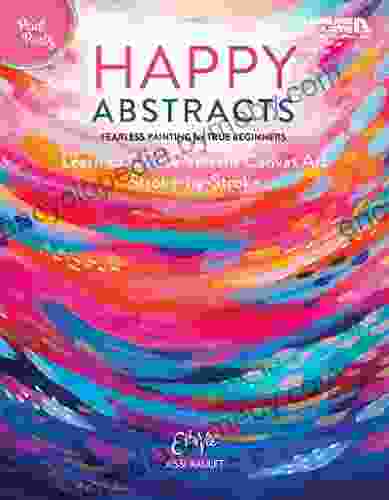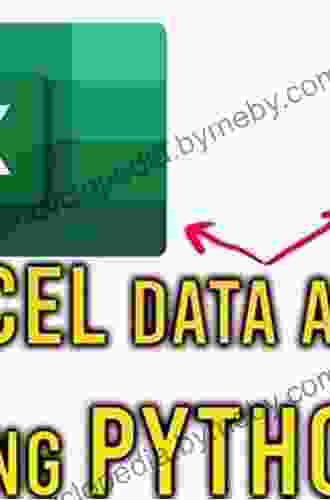From Excel to Python: A Comprehensive Guide to Data Analysis and Visualization

In today's data-driven world, data analysis and visualization are essential skills for anyone who wants to make informed decisions. Microsoft Excel has long been the go-to tool for data analysis, but Python is quickly becoming the preferred choice for data scientists and analysts.
Python is a powerful programming language that offers a wide range of libraries and tools for data analysis and visualization. It is also relatively easy to learn, making it a great choice for those who are new to programming.
This comprehensive guide will teach you how to transition from Excel to Python for data analysis and visualization. We will cover all of the basics, from data manipulation to creating stunning visualizations.
4.6 out of 5
| Language | : | English |
| File size | : | 7446 KB |
| Text-to-Speech | : | Enabled |
| Screen Reader | : | Supported |
| Enhanced typesetting | : | Enabled |
| Print length | : | 409 pages |
There are many reasons why Python is becoming the preferred choice for data analysis and visualization. Here are a few of the benefits of using Python:
- Python is a powerful programming language. It can be used to perform a wide range of tasks, from data manipulation to machine learning.
- Python has a large and active community. This means that there is a wealth of resources available to help you learn Python and use it for your own projects.
- Python is free and open source. This means that you can use it without having to pay any licensing fees.
If you are new to Python, the first step is to install the Python interpreter on your computer. You can download the Python interpreter from the official Python website.
Once you have installed the Python interpreter, you can open a Python console and start writing Python code. The Python console is a text-based environment where you can enter Python commands and see the results.
To open a Python console, simply type "python" into your terminal window. You should see a prompt that looks like this:
Python 3.6.5 (default, Apr 1 2018, 05:46:39) [GCC 4.2.1 Compatible Clang 4.0.1 (tags/RELEASE_401/final)] on darwin Type "help", "copyright", "credits" or "license" for more information. >>>
You can now start entering Python commands into the console. For example, you can try the following command to print the message "Hello, world!" to the console:
print("Hello, world!")
You should see the following output in the console:
Hello, world!
One of the most important aspects of data analysis is data manipulation. This involves cleaning, transforming, and aggregating data in Free Download to prepare it for analysis and visualization.
Python has a number of powerful libraries for data manipulation, including Pandas and NumPy. Pandas is a library for working with structured data, such as data frames and series. NumPy is a library for working with numerical data, such as arrays and matrices.
To use Pandas and NumPy, you first need to import them into your Python script. You can do this with the following commands:
import pandas as pd import numpy as np
Once you have imported Pandas and NumPy, you can start using them to manipulate your data. For example, the following code loads a CSV file into a Pandas data frame:
df = pd.read_csv("data.csv")
You can then use the Pandas data frame to clean, transform, and aggregate your data. For example, the following code drops the first row of the data frame:
df = df.drop(0)
The following code replaces the missing values in the data frame with the mean of the column:
df.fillna(df.mean(),inplace=True)
The following code groups the data frame by the "category" column and calculates the mean of the "value" column for each group:
df = df.groupby("category").mean()
Once you have cleaned and transformed your data, you can start visualizing it. Python has a number of powerful libraries for data visualization, including Matplotlib and Seaborn.
Matplotlib is a library for creating 2D plots and charts. Seaborn is a library for creating statistical graphics.
To use Matplotlib and Seaborn, you first need to import them into your Python script. You can do this with the following commands:
import matplotlib.pyplot as plt import seaborn as sns
Once you have imported Matplotlib and Seaborn, you can start using them to visualize your data. For example, the following code creates a line chart of the "value" column in the data frame:
plt.plot(df["value"])
The following code creates a scatter plot of the "x" and "y" columns in the data frame:
plt.scatter(df["x"], df["y"])
The following code creates a histogram of the "x" column in the data frame:
sns.distplot(df["x"])
This comprehensive guide has provided you with the basics of how to transition from Excel to Python for data analysis and visualization. We have covered everything from data manipulation to creating stunning visualizations.
If you want to learn more about data analysis and visualization in Python, there are a number of resources available online and in print. We encourage you to explore these resources and continue learning about this powerful tool.
Happy coding!
4.6 out of 5
| Language | : | English |
| File size | : | 7446 KB |
| Text-to-Speech | : | Enabled |
| Screen Reader | : | Supported |
| Enhanced typesetting | : | Enabled |
| Print length | : | 409 pages |
Do you want to contribute by writing guest posts on this blog?
Please contact us and send us a resume of previous articles that you have written.
 Book
Book Novel
Novel Page
Page Chapter
Chapter Text
Text Story
Story Genre
Genre Reader
Reader Library
Library Paperback
Paperback E-book
E-book Magazine
Magazine Newspaper
Newspaper Paragraph
Paragraph Sentence
Sentence Bookmark
Bookmark Shelf
Shelf Glossary
Glossary Bibliography
Bibliography Foreword
Foreword Preface
Preface Synopsis
Synopsis Annotation
Annotation Footnote
Footnote Manuscript
Manuscript Scroll
Scroll Codex
Codex Tome
Tome Bestseller
Bestseller Classics
Classics Library card
Library card Narrative
Narrative Biography
Biography Autobiography
Autobiography Memoir
Memoir Reference
Reference Encyclopedia
Encyclopedia Shalabh Aggarwal
Shalabh Aggarwal Jeremiah Lynch
Jeremiah Lynch Christa Mackinnon
Christa Mackinnon Avinash Navlani
Avinash Navlani Andie Mitchell
Andie Mitchell Mark Hyman
Mark Hyman Leon Edward
Leon Edward A Craig Copetas
A Craig Copetas A L Knorr
A L Knorr Russ Baker
Russ Baker James Oliver Curwood
James Oliver Curwood Sean Hartlieb
Sean Hartlieb A M Wilson
A M Wilson Barak A Bassman
Barak A Bassman A J Markam
A J Markam Abdulrazak Gurnah
Abdulrazak Gurnah Steve Lehto
Steve Lehto Rona Arato
Rona Arato A Sulthan
A Sulthan Olivia Rana
Olivia Rana
Light bulbAdvertise smarter! Our strategic ad space ensures maximum exposure. Reserve your spot today!
 Rick NelsonFollow ·16.2k
Rick NelsonFollow ·16.2k Henry GreenFollow ·8.8k
Henry GreenFollow ·8.8k Ryan FosterFollow ·16.2k
Ryan FosterFollow ·16.2k Douglas FosterFollow ·5k
Douglas FosterFollow ·5k Stephen KingFollow ·5.7k
Stephen KingFollow ·5.7k Dawson ReedFollow ·16.1k
Dawson ReedFollow ·16.1k Alvin BellFollow ·17k
Alvin BellFollow ·17k Arthur Conan DoyleFollow ·18.3k
Arthur Conan DoyleFollow ·18.3k

 Timothy Ward
Timothy WardFearless Painting for True Beginners: Learn to Create...
Unlock the Joy of...

 Fernando Pessoa
Fernando PessoaProven 12-Step Program for Financial Peace of Mind:...
Are you struggling with...

 Chinua Achebe
Chinua AchebeLayers Colors Desire: Layers Colors Thoughts Mystery
A Literary Labyrinth...

 Fernando Bell
Fernando BellUnearth Hidden Treasures: Journey Through "Secondhand...
Prepare to embark on an extraordinary...

 Caleb Carter
Caleb CarterSymbolic Messages Garage Sale Mysteries: Unveiling the...
Welcome to the extraordinary world of the...

 Nikolai Gogol
Nikolai GogolTravels in the Billion Dollar Trash Trade: Uncovering the...
Ỡ In his...
4.6 out of 5
| Language | : | English |
| File size | : | 7446 KB |
| Text-to-Speech | : | Enabled |
| Screen Reader | : | Supported |
| Enhanced typesetting | : | Enabled |
| Print length | : | 409 pages |












